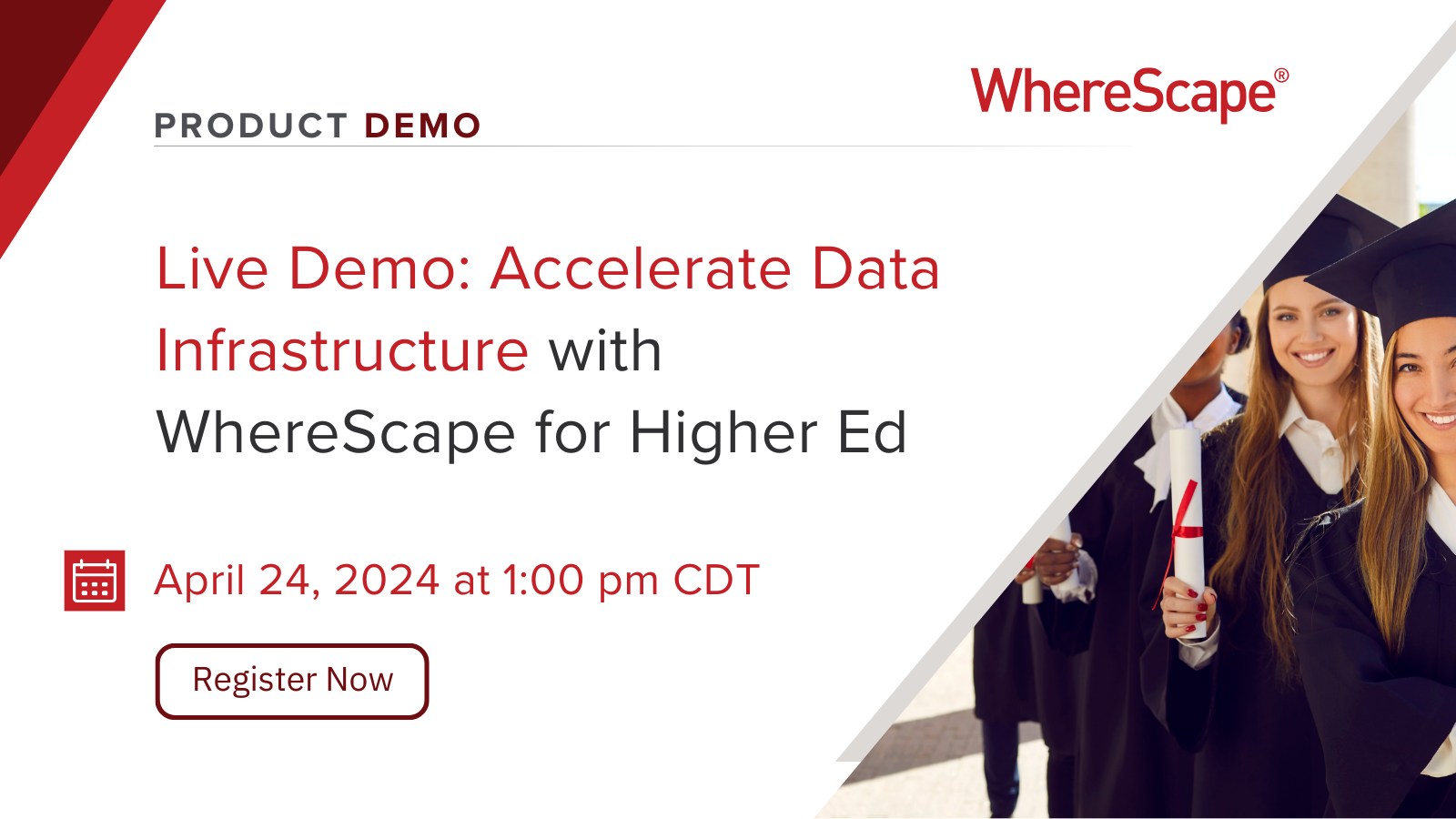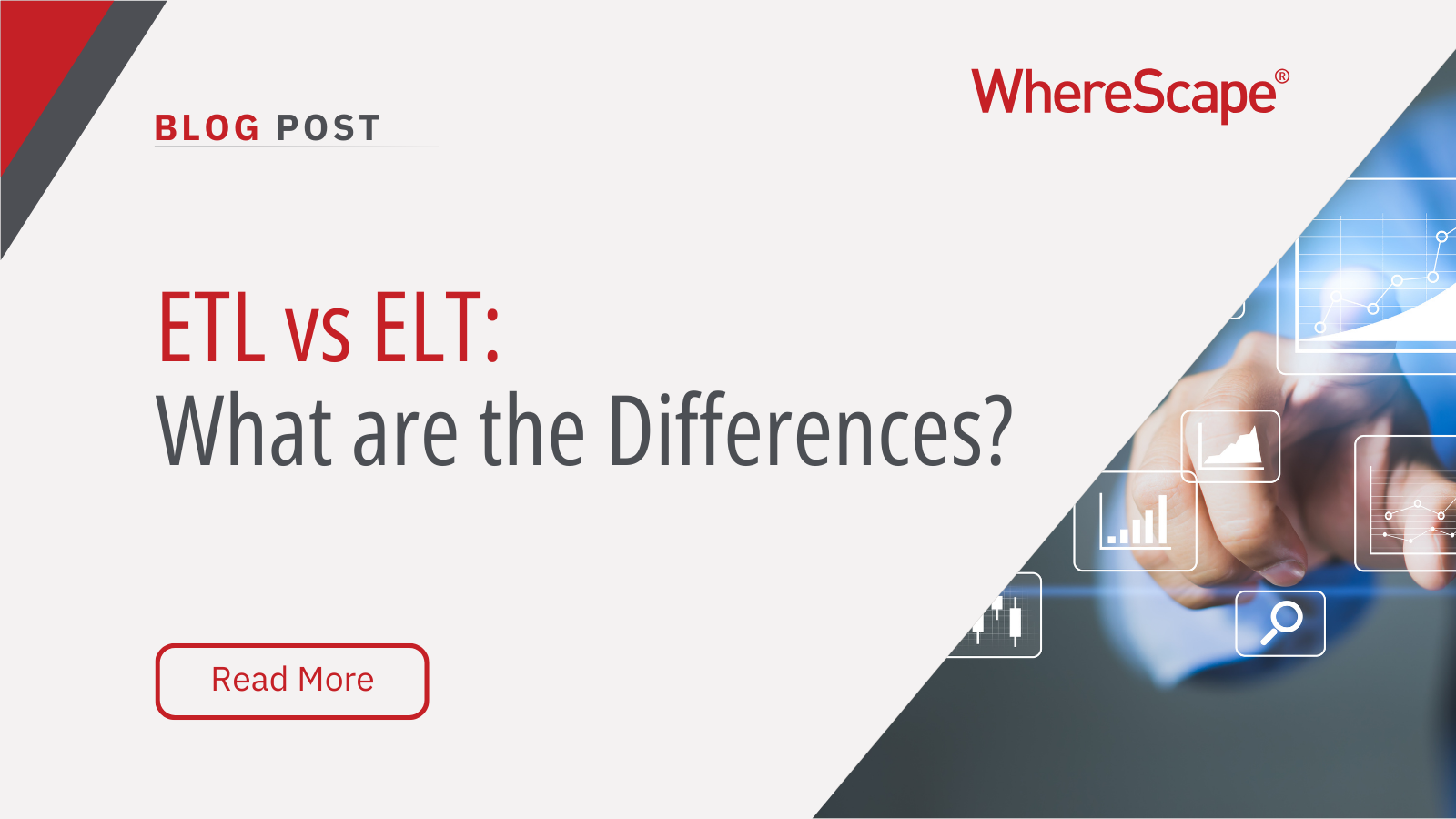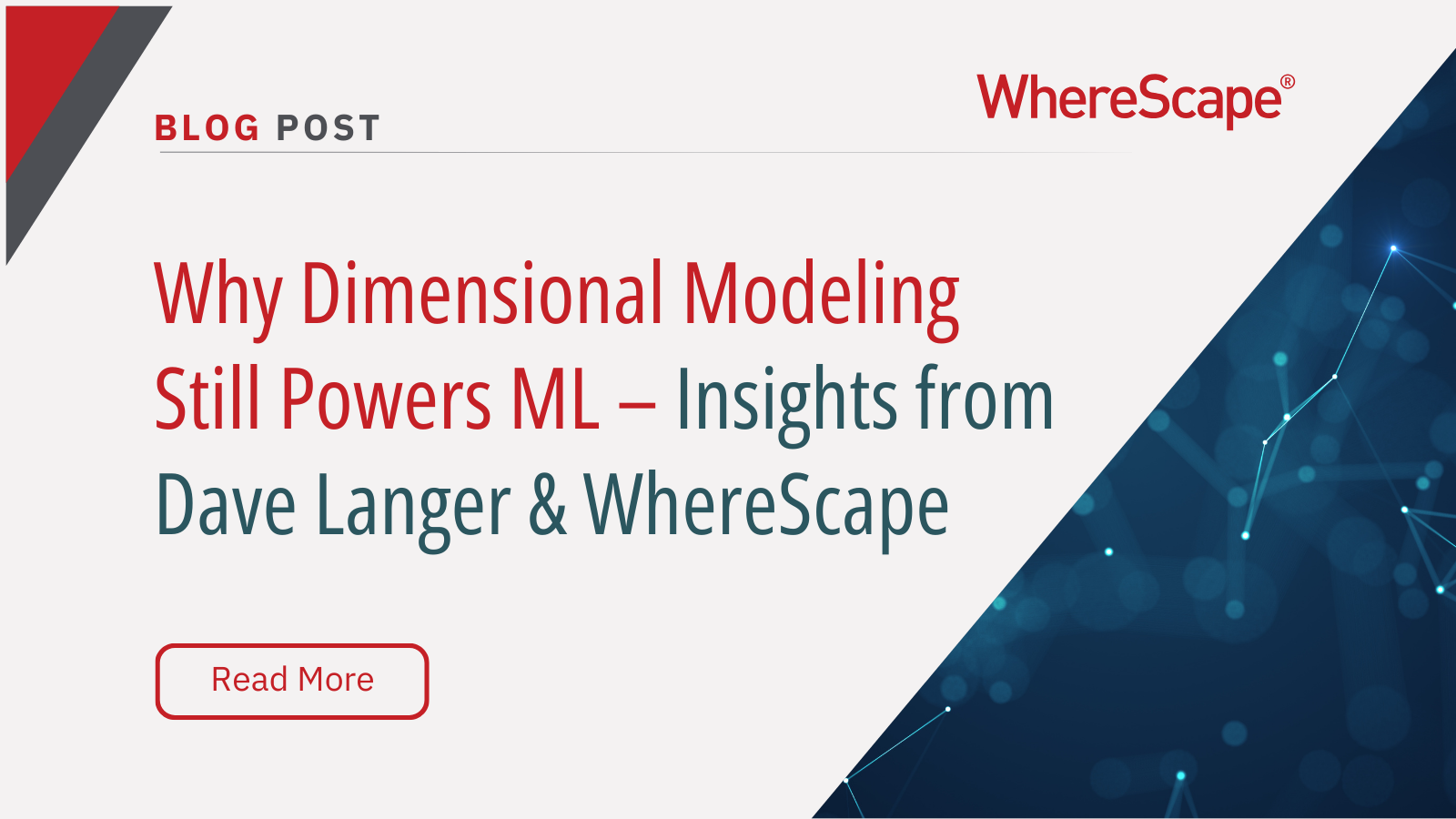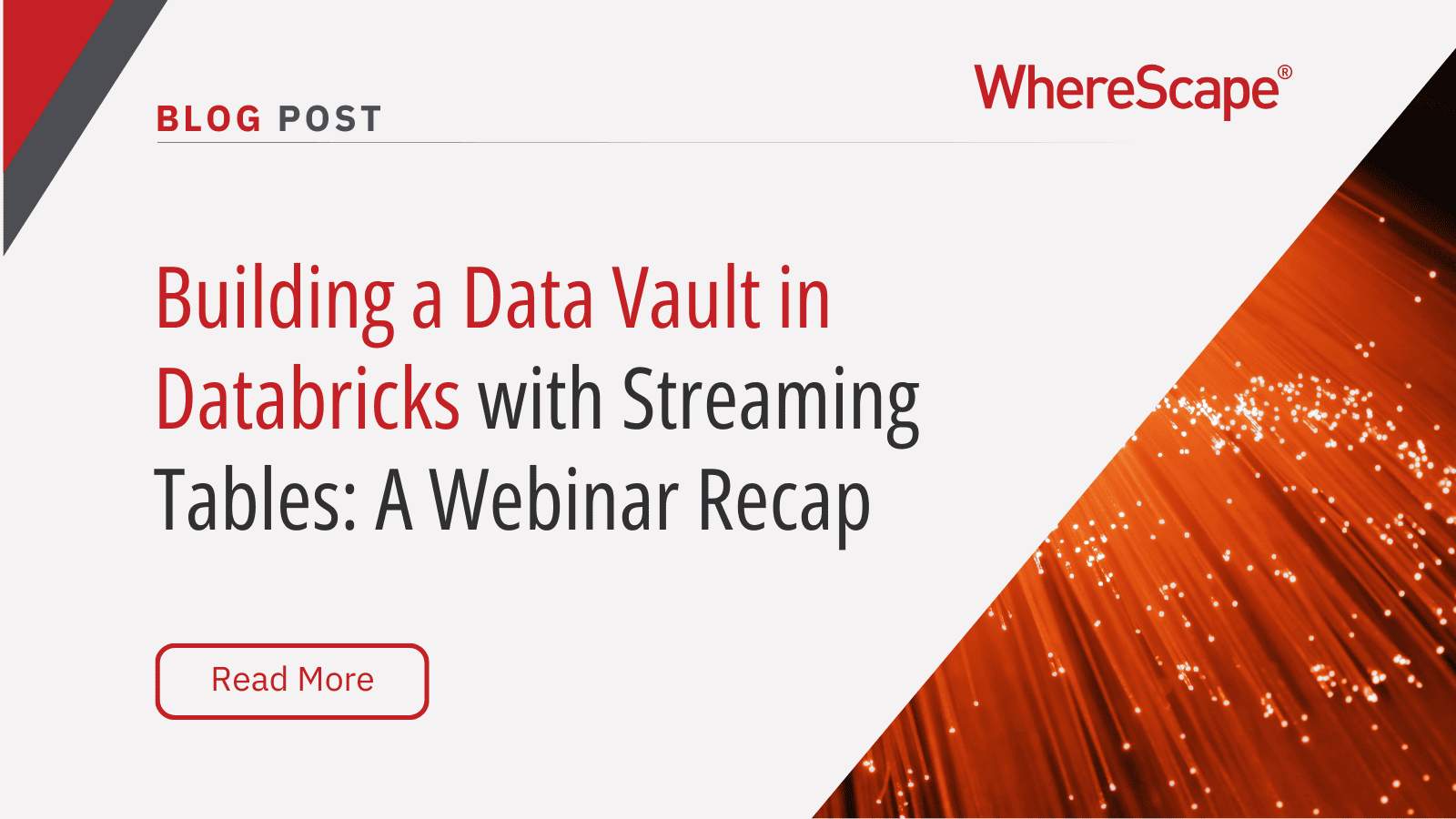Join us for a 60-minute live demo of...
Simplify Cloud Migrations: Webinar Highlights from Mike Ferguson
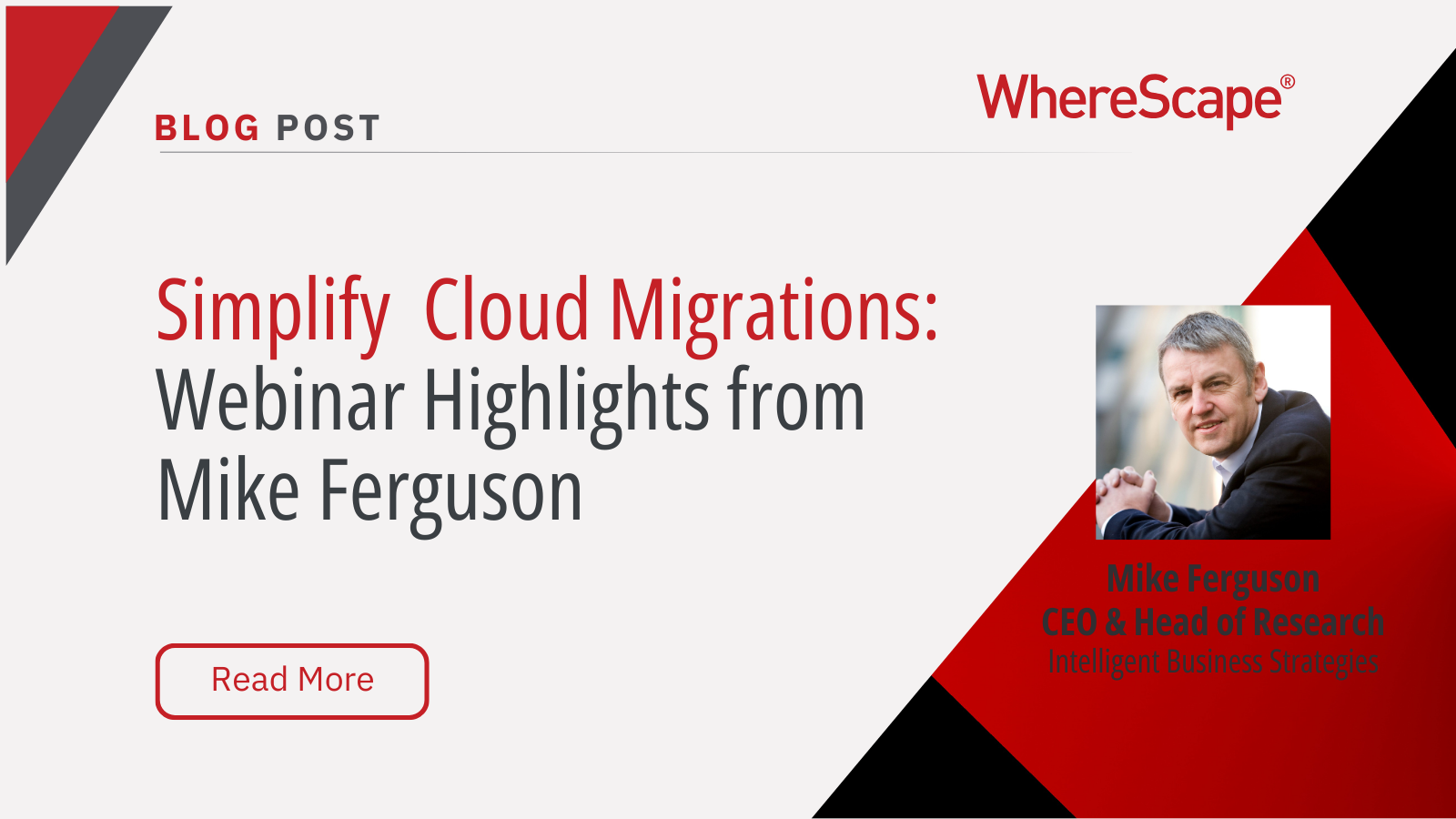
Migrating your data warehouse to the cloud might feel like navigating uncharted territory, but it doesn’t have to be. In a recent webinar that we recently hosted, Mike Ferguson, CEO of Intelligent Business Strategies, shared actionable insights drawn from his 40+ years in IT. His expertise helped demystify the process, offering organizations practical advice to streamline their migration journey.
Below, we’ve recapped the key highlights from the webinar, including direct insights from Mike, to provide you with a clear roadmap for your cloud migration efforts.
Why Migrate to the Cloud?
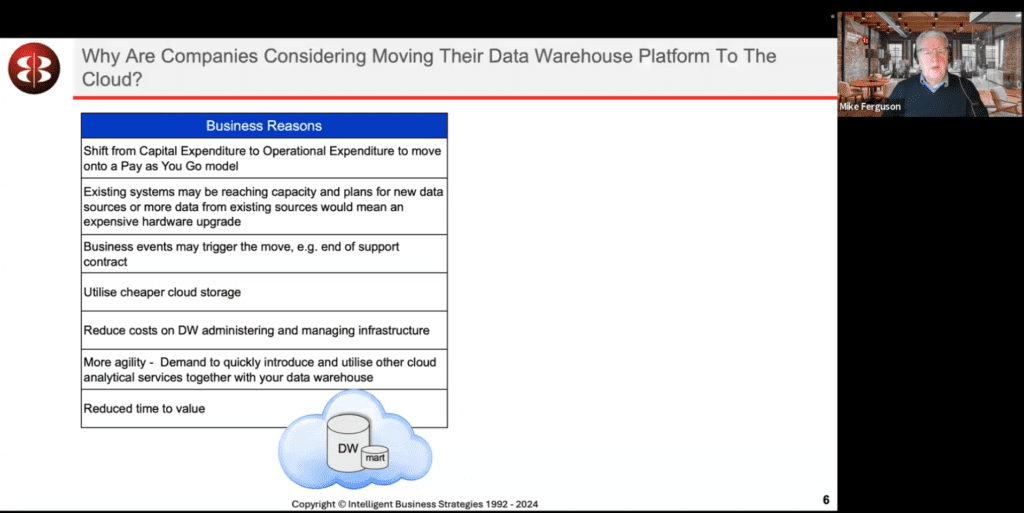
Mike began by addressing the question on every organization’s mind: why make the leap to the cloud? He highlighted several compelling reasons:
- Cost Savings: “Migrating to the cloud allows organizations to eliminate the high costs of maintaining on-premises infrastructure and switch to a scalable, pay-as-you-go model.” By reducing hardware investments and ongoing maintenance, businesses can allocate budgets toward innovation and growth.
- Scalability: The elasticity of cloud platforms allows businesses to scale storage and compute power as needed, without over-investing in unused capacity. “The cloud enables you to grow with your business,” Mike noted, highlighting its adaptability during periods of peak demand.”
- Technology Modernization: “Legacy systems are not built for today’s fast-moving environment,” Mike explained. Cloud platforms allow organizations to leverage modern tools like serverless computing, AI-driven analytics, and integrated security measures to stay competitive in an ever-evolving digital landscape.
- Advanced Analytics: From machine learning to real-time insights, the cloud opens doors to analytics capabilities that aren’t easily achievable with legacy systems. Mike added, “The cloud provides the foundation for real-time decision-making, helping businesses turn data into actionable insights.”
With these benefits in mind, it’s clear why so many organizations are embarking on this journey. Mike also noted that cloud migration isn’t just about cost or technology—it’s about creating a competitive advantage and future-proofing your business. “The question isn’t ‘why the cloud,’ but ‘how soon can you get there?'” he concluded.
Breaking Down the Migration Process
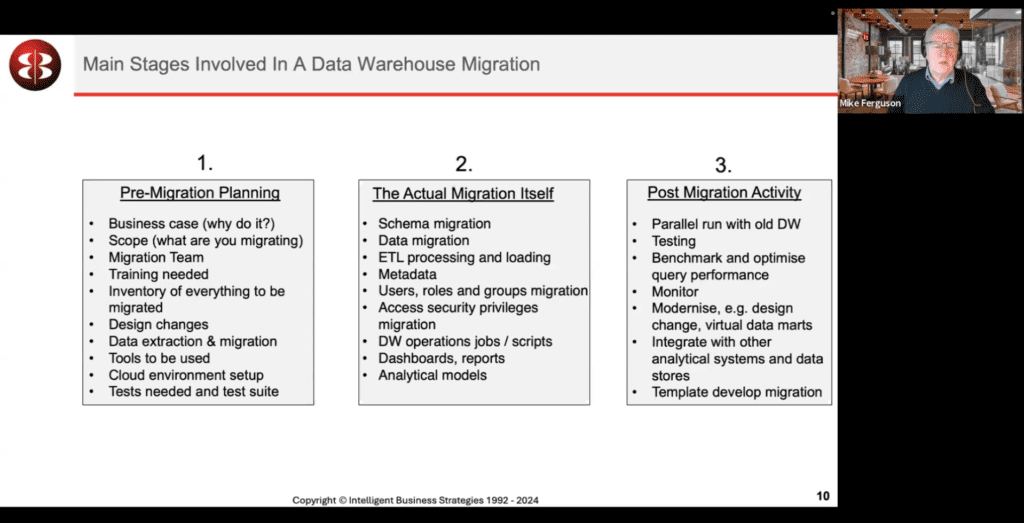
Mike Ferguson broke the migration process into three distinct phases:
Pre-Migration Planning
- Define Clear Goals and Objectives: Ensure your migration efforts align with business objectives like reducing costs, enhancing analytics capabilities, or improving scalability.
- Assess Your Current Data Warehouse: Understand its structure, dependencies, and performance requirements to avoid surprises later.
- Train Your Team: Equip your staff with the skills and knowledge needed to manage the new cloud environment efficiently.
- Create a Migration Roadmap: Prioritize tasks, define timelines, and allocate resources effectively to keep the project on track.
Migration Execution
- Decide on a Strategy:
- Lift-and-shift: Move data as is, ideal for quicker transitions.
- Re-platforming: Optimize data architecture to better fit the cloud.
- Full redesign: Reimagine your data warehouse for maximum efficiency and scalability.
- Address Schema and Data Compatibility Challenges: Leverage tools to handle differences in formats, data types, and SQL extensions.
- Migrate ETL Processes and Security Settings: Ensure all Extract, Transform, Load (ETL) pipelines and access controls are configured appropriately for the cloud.
- Leverage Automation Tools: Tools like WhereScape simplify complex tasks, ensuring a faster, smoother migration.
Post-Migration Activities
- Validate Performance and Data Integrity: Run comprehensive tests to ensure the migrated system performs as expected.
- Transition Applications and Users Seamlessly: Minimize downtime and disruptions with a structured onboarding process.
- Monitor and Optimize: Continuously track performance metrics and optimize workflows to maximize ROI.
Overcoming Common Challenges
While the migration process can be rewarding, it’s not without hurdles. Mike discussed several challenges organizations often face and shared tips to overcome them:
- Database Compatibility: “Schema mismatches and data type inconsistencies are common,” Mike shared. Addressing these early can prevent costly delays.
- Large Data Volumes: Leverage bulk data movement tools to transfer data efficiently.
- Testing and Validation: “Testing isn’t optional,” Mike stressed. Developing repeatable test cases ensures performance and data accuracy in the new environment.
How WhereScape Simplifies the Journey
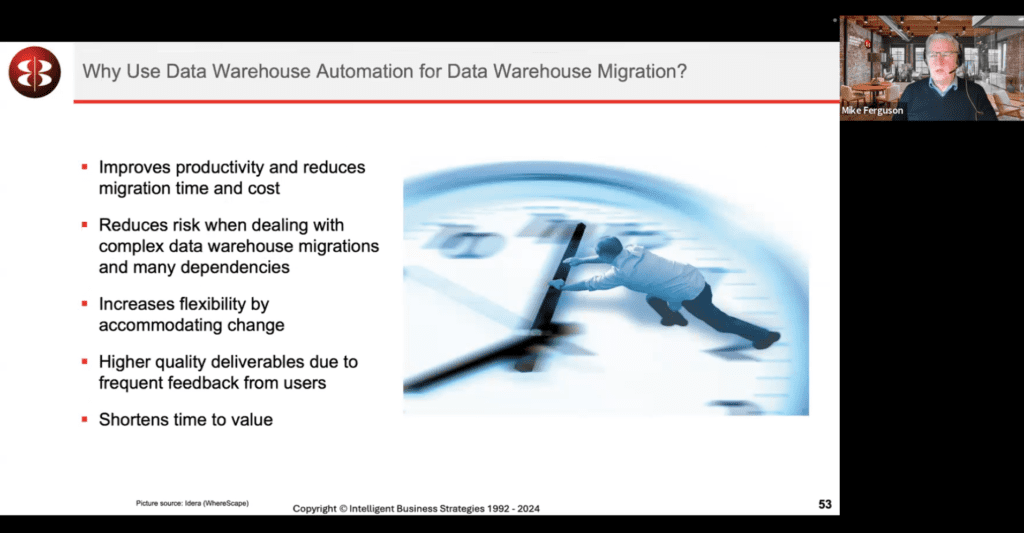
At WhereScape, we understand the complexities of cloud migrations and migrating your data warehouse to the cloud. That’s why our automation tools are designed to simplify the process and ensure success. By automating key tasks like data modeling, ETL, and documentation, our solutions:
- Reduce Manual Effort: Eliminate up to 95% of hand coding, allowing your teams to focus on strategic tasks.
- Accelerate Timelines: With WhereScape, your migration journey is faster and less disruptive, enabling quicker access to the benefits of the cloud.
- Improve Consistency: Standardize and streamline data processes for reliable, repeatable outcomes across the organization.
Our tools integrate seamlessly with leading cloud platforms like Azure, AWS, Google Cloud, Databricks, Microsoft Fabric, and Snowflake, making the transition smoother than ever. During the webinar, Mike Ferguson emphasized how automation tools like WhereScape are essential in mitigating risks and ensuring successful migrations.
Best Practices for a Smooth Migration
To ensure success, follow these migration best practices:
- Assess and Simplify: Conduct a thorough inventory of your data to identify what’s essential. Be sure to archive or remove redundant data before migrating to streamline the process.
- Plan for Future Needs: Design your architecture with scalability and modernization in mind, ensuring that it can handle future workloads and emerging technologies.
- Leverage Automation: Tools like WhereScape automate repetitive tasks such as schema translations and ETL processes, reducing errors and speeding up implementation.
- Focus on Users: Ensure minimal disruption by shielding users from backend changes. Invest in training and support to ease the transition.
Unlocking Opportunities Post-Migration
Cloud migration marks the start of a new chapter filled with potential for innovation and optimization. After your data is in the cloud, you can modernize further by adopting lakehouse models, which combine the advantages of data lakes and warehouses to create a unified analytics environment.
Real-time analytics also become more accessible, enabling quicker and more informed decision-making. Advanced integrations with cloud-native tools open doors to capabilities like machine learning, AI, and predictive analytics, further enhancing business value. Moreover, robust data governance frameworks in the cloud strengthen compliance and security, helping organizations meet regulatory requirements effortlessly.
“Migration is the foundation for modernization,” Mike said. “It’s what comes after that defines your competitive edge.”
Ready to Begin Your Journey?
Migrating your data warehouse to the cloud is a critical step toward achieving scalability, modernization, and advanced analytics capabilities. In this blog, we explored key insights from Mike Ferguson on why cloud migration matters, how to approach it strategically, and how WhereScape’s automation tools like WhereScape RED, WhereScape 3D, and WhereScape DVE, simplify the process. From cost savings to real-time analytics opportunities, the benefits are clear—and with the right tools, the transition doesn’t have to be overwhelming.
Watch the full webinar on-demand HERE to gain expert insights from Mike Ferguson. See how WhereScape can simplify your cloud migration—book a personalized demo with our team today.
ETL vs ELT: What are the Differences?
In working with hundreds of data teams through WhereScape’s automation platform, we’ve seen this debate evolve as businesses modernize their infrastructure. Each method, ETL vs ELT, offers a unique pathway for transferring raw data into a warehouse, where it can be...
Dimensional Modeling for Machine Learning
Kimball’s dimensional modeling continues to play a critical role in machine learning and data science outcomes, as outlined in the Kimball Group’s 10 Essential Rules of Dimensional Modeling, a framework still widely applied in modern data workflows. In a recent...
Automating Data Vault in Databricks | WhereScape Recap
Automating Data Vault in Databricks can reduce time-to-value by up to 70%—and that’s why we hosted a recent WhereScape webinar to show exactly how. At WhereScape, modern data teams shouldn't have to choose between agility and governance. That's why we hosted a live...
WhereScape Recap: Highlights From Big Data & AI World London 2025
Big Data & AI World London 2025 brought together thousands of data and AI professionals at ExCeL London—and WhereScape was right in the middle of the action. With automation taking center stage across the industry, it was no surprise that our booth and sessions...
Why WhereScape is the Leading Solution for Healthcare Data Automation
Optimizing Healthcare Data Management with Automation Healthcare organizations manage vast amounts of medical data across EHR systems, billing platforms, clinical research, and operational analytics. However, healthcare data integration remains a challenge due to...
WhereScape Q&A: Your Top Questions Answered on Data Vault and Databricks
During our latest WhereScape webinar, attendees had fantastic questions about Data Vault 2.0, Databricks, and metadata automation. We’ve compiled the best questions and answers to help you understand how WhereScape streamlines data modeling, automation, and...
What is Data Fabric? A Smarter Way for Data Management
As of 2023, the global data fabric market was valued at $2.29 billion and is projected to grow to $12.91 billion by 2032, reflecting the critical role and rapid adoption of data fabric solutions in modern data management. The integration of data fabric solutions...
Want Better AI Data Management? Data Automation is the Answer
Understanding the AI Landscape Imagine losing 6% of your annual revenue—simply due to poor data quality. A recent survey found that underperforming AI models, built using low-quality or inaccurate data, cost companies an average of $406 million annually. Artificial...
RED 10: The ‘Git Friendly’ Revolution for CI/CD in Data Warehousing
For years, WhereScape RED has been the engine that powers rapidly built and high performance data warehouses. And while RED 10 has quietly empowered organizations since its launch in 2023, our latest 10.4 release is a game changer. We have dubbed this landmark update...
The Assembly Line for Your Data: How Automation Transforms Data Projects
Imagine an old-fashioned assembly line. Workers pass components down the line, each adding their own piece. It’s repetitive, prone to errors, and can grind to a halt if one person falls behind. Now, picture the modern version—robots assembling products with speed,...
Related Content
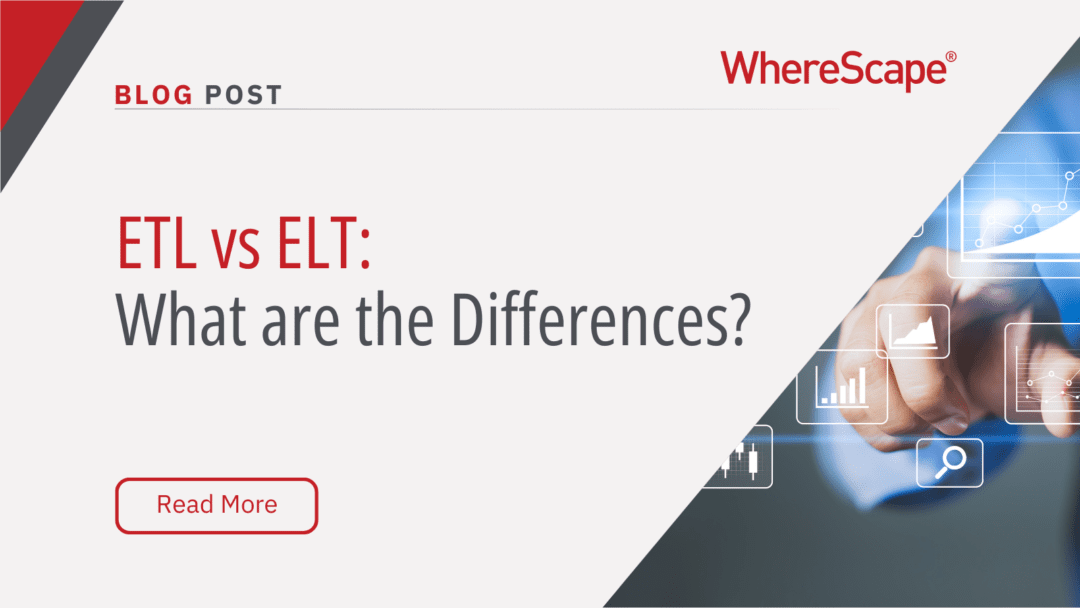
ETL vs ELT: What are the Differences?
In working with hundreds of data teams through WhereScape’s automation platform, we’ve seen this debate evolve as businesses modernize their infrastructure. Each method, ETL vs ELT, offers a unique pathway for transferring raw data into a warehouse, where it can be...
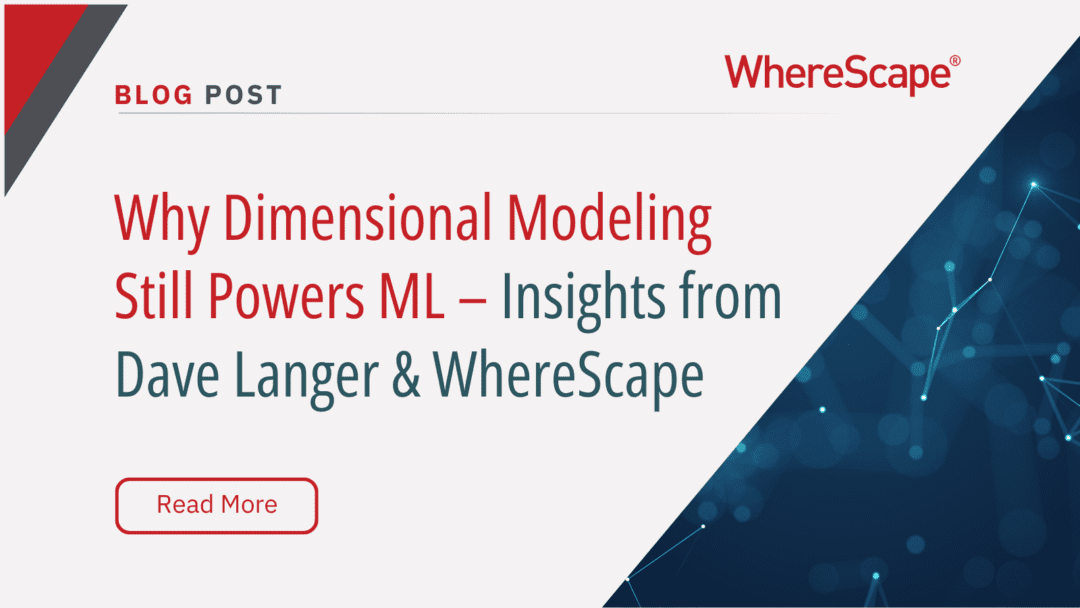
Dimensional Modeling for Machine Learning
Kimball’s dimensional modeling continues to play a critical role in machine learning and data science outcomes, as outlined in the Kimball Group’s 10 Essential Rules of Dimensional Modeling, a framework still widely applied in modern data workflows. In a recent...
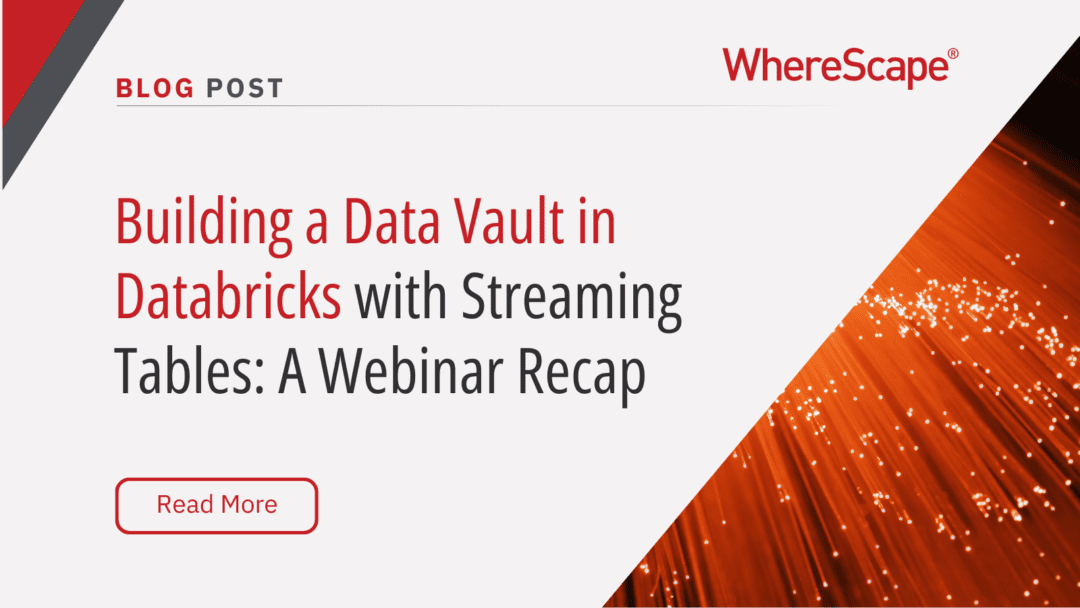
Automating Data Vault in Databricks | WhereScape Recap
Automating Data Vault in Databricks can reduce time-to-value by up to 70%—and that’s why we hosted a recent WhereScape webinar to show exactly how. At WhereScape, modern data teams shouldn't have to choose between agility and governance. That's why we hosted a live...
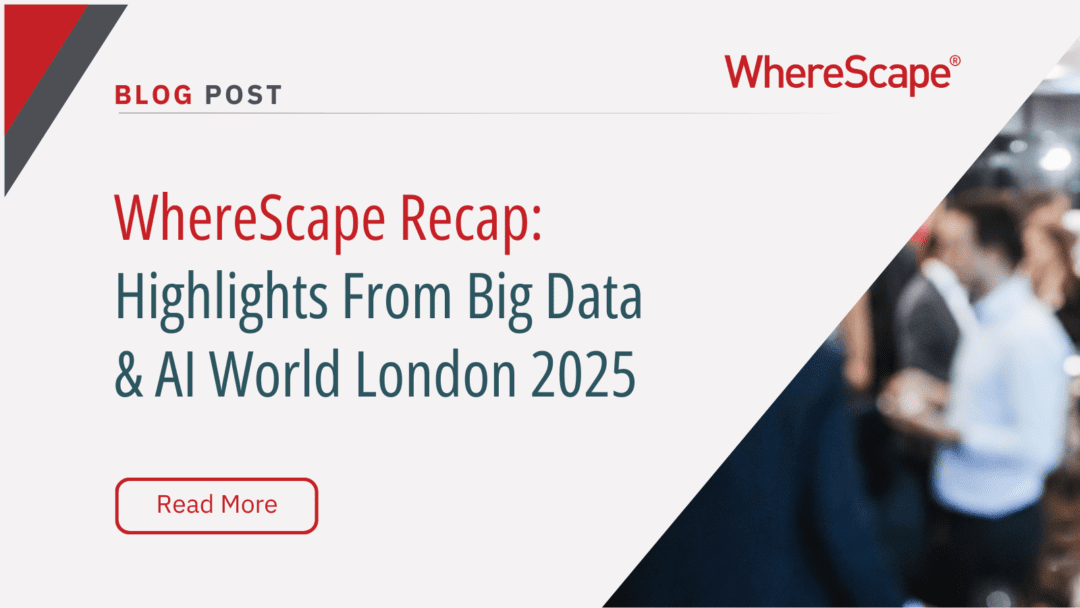
WhereScape Recap: Highlights From Big Data & AI World London 2025
Big Data & AI World London 2025 brought together thousands of data and AI professionals at ExCeL London—and WhereScape was right in the middle of the action. With automation taking center stage across the industry, it was no surprise that our booth and sessions...

